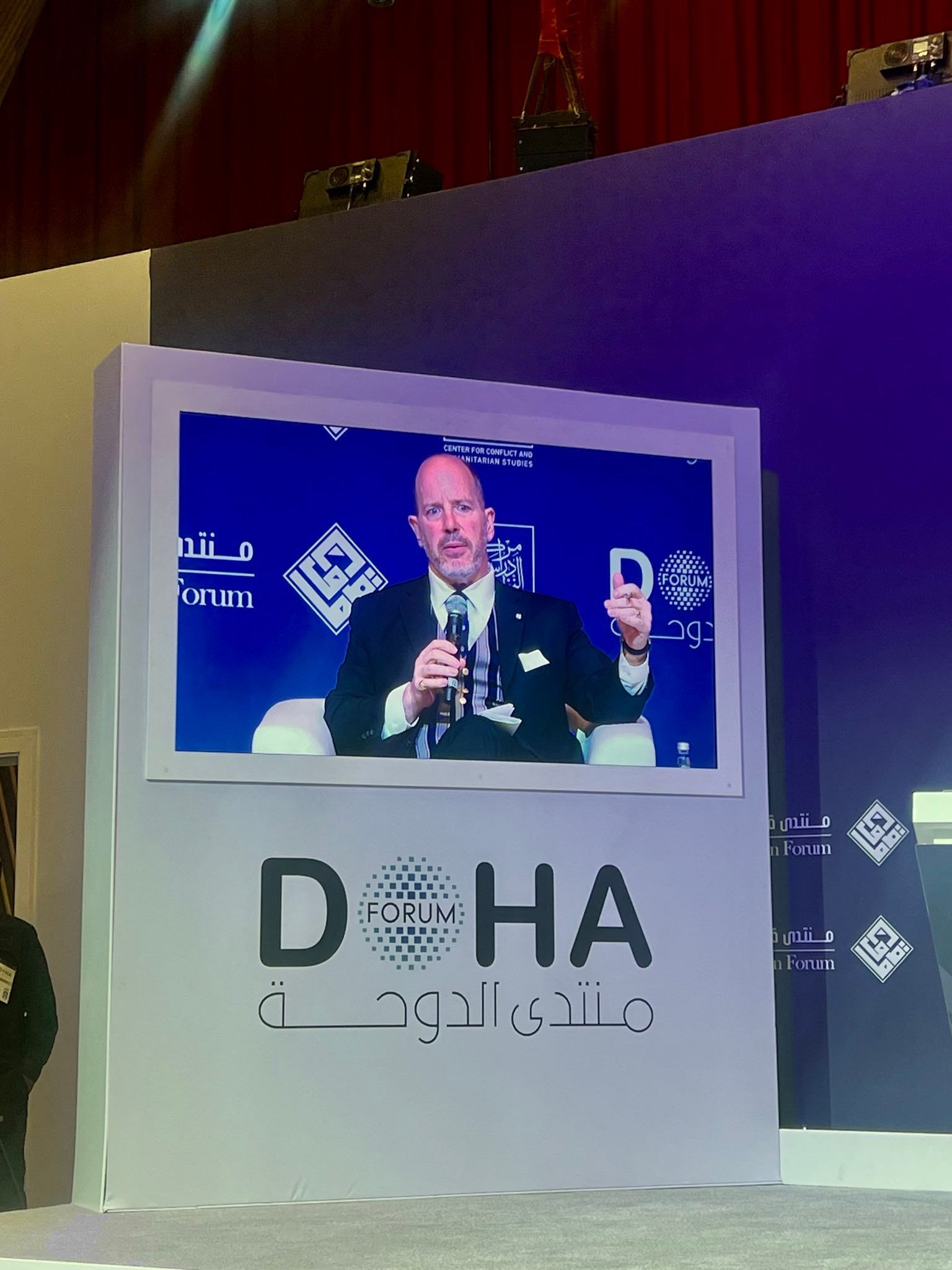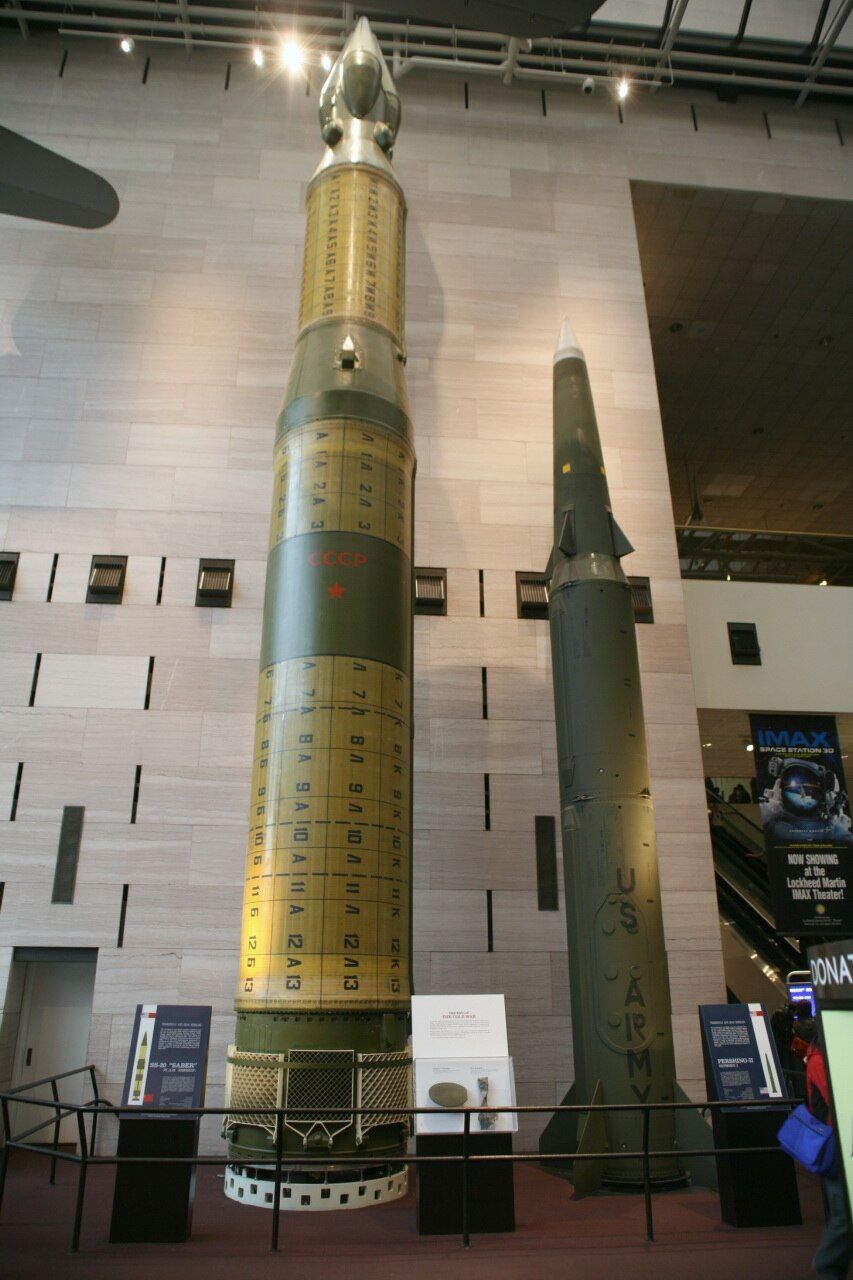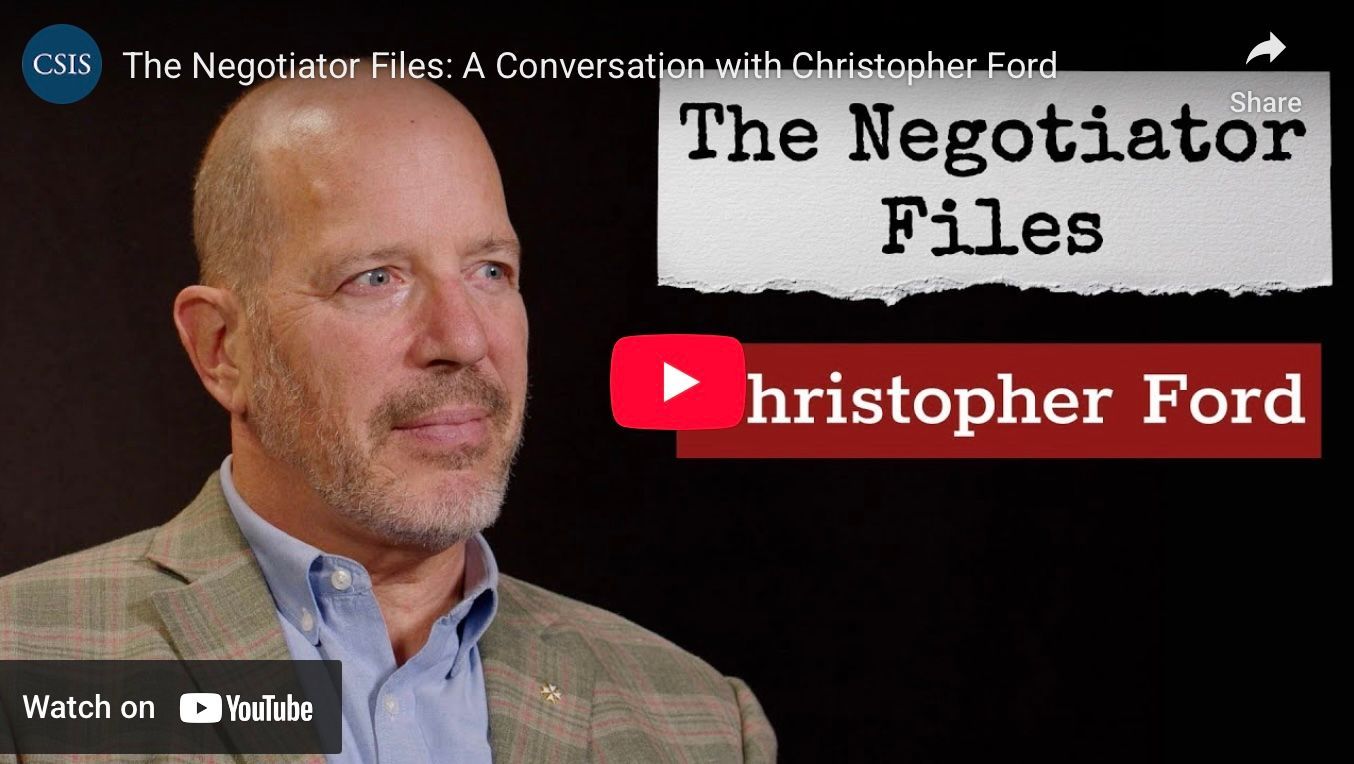The New U.S. Policy on UAS Exports: Responsibly Implementing the MTCR’s “Presumption of Denial”
Below is the text of the thirteenth paper in the ACIS Papers series produced by the Office of the Under Secretary of State for Arms Control and International Security. This paper may also be found in PDF form at the bottom of this page.
The New U.S. Policy on UAS Exports: Responsibly Implementing the MTCR's "Presumption of Denial"
by
Dr. Christopher A. Ford
Arms Control and International Security Paper Series
Volume I, Number 13
July 24, 2020
In this ACIS Paper , Assistant Secretary Ford recounts the United States’ effort to reform the Missile Technology Control Regime (MTCR) controls with respect to a subcategory of Unmanned Aerial Systems, and explains the new U.S. national approach to implementing the MTCR’s “strong presumption of denial” for proliferation-responsible transfers of “Category I” items under the MTCR Guidelines.
The Missile Technology Control Regime (MTCR) is an association of partner countries united by their subscription to a series of political commitments recognizing the importance of restraint in transfers of nuclear-capable ballistic missiles and cruise missiles, which are defined for MTCR purposes as systems that are capable of delivering at least a 500 kilogram payload to a range of at least 300 kilometers. The discussions that led to the MTCR’s formation began in 1983, among France, Germany, Italy, the United Kingdom, and the United States. These five countries — joined by Canada and Japan — formally announced the creation of the MTCR in April 1987. It now has 35 participating governments.
For most of its history, the MTCR has functioned quite well. First, Partners who make up the MTCR have acted with much more restraint than would surely otherwise have been the case, while the MTCR has also has served as the de facto missile nonproliferation standard globally and the example that even responsible governments not in the Regime have looked to follow. While there unfortunately has been all too much missile proliferation in the world, the worst of it has been — and continues to be — from MTCR non -partners, such as: North Korea, with its track record of selling missiles and related to technology to any country willing to pay for them; Chinese entities that continue to act as the major source of missile-related equipment to programs of proliferation concern in Iran, North Korea, Syria, and Pakistan; and Iran, with its egregious and ongoing transfers of missile technology to Lebanese Hizbollah terrorists and to Houthi militia groups in Yemen. We continue to work with countries to call attention to the problem of missile proliferation and urge them to take steps to address it. We do this bilaterally, through our participation in the MTCR, and through other appropriate international fora. For example, last November the U.S. and Poland convened a working group meeting of the Warsaw Process to draw attention to these problems and urge the international community to do more to keep such missile proliferation from further destabilizing the Middle East.
I. The Challenge of Keeping the Regime Up to Date
As I pointed out at an event at Hudson Institute in February 2019 , however, the 1980s-era technological benchmark built into the MTCR Guidelines — that is, the “500 kilograms to 300 kilometers” definition — has not fared well in recent years. Dramatic advances in unmanned aerial systems (UAS) have led to a great explosion in the capabilities and beneficial uses of so-called “drone” aircraft that technically meet this definition, but which in no way present the kind of nuclear weapon delivery threat that the MTCR was established in order to help forestall. As applied to many UAS, in other words, the MTCR is gravely out of date.
This mismatch presents a real challenge to the efficacy and the future of the MTCR regime, for the MTCR Guidelines call for partners to follow a “strong presumption of denial” for transfers of so-called “Category I” items — that is, such things as
With respect to actual missiles and rockets, or the sort of high-performance cruise missile that would most likely be used deliver a nuclear weapon, this makes good sense. For far less capable varieties of UAS, however, the presumption of denial has the effect of shutting MTCR partners out of an important, growing, and (in nuclear weapons terms) quite non-threatening UAS market, while leaving non -partners free to sell whatever they wish to whomever they wish.
This is a net loss not just for the MTCR Partners themselves, but also for the cause of nonproliferation: in practice, the market for such non-threatening UAS is ceded to the least proliferation-responsible international players. No one intended the MTCR to be a marketing tool for missile brokers such as the PRC or Iran, but thanks to the MTCR’s rigidity as technology has advanced, there’s a real risk of that happening.
To be sure, this risk is to some extent inherent in the MTCR’s structure, since responsible MTCR participants both do and should generally refuse to sell high-threat Category I systems, therefore necessarily leaving some potential market opportunities open for suppliers outside the MTCR. For this to happen even with low-threat types of UAS that technically meet the Category I definition, however, seems needless and perverse. As I summed it up in February 2019,
This challenge illustrates the ways in which, in an arena as characterized by the swift advance of technology as is the world of aerospace engineering and UAS applications, the passage of time can do damage to even the wisest set of standards if those rules are based upon fixed technological parameters. (That is why, for instance, in our current work at the U.S. State Department to promote the development of norms of responsible behavior in cyberspace, we have tried to make these standards as “technology-agnostic” as possible — such as by trying to define irresponsible cyber behavior by its effects rather than based upon the use of any particular tool or method in the fast-developing environment of cyberspace.) With respect to lower-threat UAS, the technological understandings of 1987 are now not only out of date, but also in real danger of becoming counterproductive.
II. The U.S. MTCR Reform Proposal
For these reasons, the United States in March 2018 proposed an adjustment to the MTCR controls that would carve out a carefully selected subset of Category I UAS for treatment as if they were Category II systems. As first proposed, this subset was to be based upon a speed threshold, allowing more lenient treatment for those UAVs, other than cruise missiles, based on a representative maximum speed value of less than 800 kilometers per hour, [1] and with appropriate end-use statements and end-user assurances, including that these systems will not be used for the delivery of weapons of mass destruction. [2] In effect, this proposed MTCR reform would have updated the framework to “ allow more permissive treatment of run-of-the-mill, basically non-WMD-related modern UAS that are useful, and indeed in today’s world all but essential, for a range of non-WMD military and an exploding universe of peaceful civilian applications.”
Nothing we were proposing would have relaxed MTCR standards applying to high-threat systems such as cruise missiles, advanced unmanned combat aerial vehicles (UCAVs), or hypersonic aerial vehicles. Our proposal included only the lower-threat systems — such as ordinary, slow, fixed-wing UAS, along with rotary wing systems and lighter-than-air craft — that would become subject to Category II treatment. And even transfers of these comparatively unproblematic systems would remain subject to careful nonproliferation considerations, pursuant to well-established MTCR principles. Lower-threat systems would also be covered by the new standards of international conduct that we are currently negotiating in order to cover the uses of UAS, especially armed UAS.
All in all, we judged that this proposal would protect what needed to be protected in the MTCR framework, while allowing a degree of relaxation for transfers of lower-threat systems in order to permit all of mankind better to take advantage of the myriad ways in which such systems are increasingly used for great benefit both in governmental applications and in the private sector.
We thought this reform proposal made eminent sense, and over more than two years we have worked diligently to build support for it among the 34 other MTCR Partners through a series of diplomatic engagements at various levels, from highly technical experts up to senior policy and political leaders. These issues have been discussed and debated, for instance, at five MTCR Technical Experts Meetings, two meetings of the regime’s Reinforced Points of Contact forum, and two meetings of the full MTCR plenary, not to mention in innumerable bilateral engagements. We have also repeatedly made technical changes and various other adjustments to our reform proposal in response to issues raised and ideas suggested by other MTCR partners.
Nevertheless, the MTCR is a consensus-based organization, in which even a single country — such as, for instance, a bellicose geopolitical revisionist — can hold up even the most sensible reform indefinitely. We are pleased that many of our MTCR partners have supported our reform proposal, but it has become clear that thanks to foot-dragging by some, it is not yet possible to amend the MTCR controls by agreement.
This is certainly disappointing, because for all of the reasons outlined above, it would have been far better for the regime if the U.S. proposal had been adopted. We will certainly keep trying, and perhaps indeed the last of our recalcitrant MTCR partners will in time come around. Nevertheless, as then-NSC Senior Director Tim Morrison and I made quite clear at Hudson Institute in February 2019, as we have sought to update the MTCR and keep it relevant and effective in an age of rapidly advancing technology, the United States’ patience was not going to be unlimited.
To repeat, the United States still hopes to gain support for the proposed MTCR reform. In the interim, however, we are not willing to sit on our hands as the technological mismatch between MTCR standards and the modern era of UAS technology erodes the effectiveness of the regime, works against the interests of the MTCR partners, and impedes progress in the world’s ability to take advantage of low-WMD-threat UAS for a wide range of commercial and governmental purposes.
III. The New U.S. National Policy
Accordingly, the United States is now implementing a new national policy on the export of Category I unmanned aerial systems. This policy does not derogate from MCTR principles; it is, in fact, entirely consistent both with the letter and with the spirit of the MTCR Guidelines. We are taking this step within the MTCR framework and in accordance with its principles, for it is an extremely valuable regime in which we continue to be a participant and of which we remain a very strong supporter. What we are doing is merely to build out a balanced and nuanced national policy within the MTCR framework that will — at least with regard to U.S. exports , anyway — help address the problems of regime implementation that have become so clear in recent years.
A. Implementing the Presumption of Denial
The key to understanding this new U.S. policy is to remember how the MTCR operates. As noted earlier, the Guidelines specify that for Category I items, “ there will be a strong presumption to deny such transfers.” The critical point here, however, is that this is not a prohibition upon all such transfers: there is merely a presumption that Category I items will not be exported. (The closest the MTCR comes to an actual prohibition is with regard to the transfer of production facilities. “Until further notice,” the Guidelines provide, “the transfer of Category I production facilities will not be authorised.”) All transfers are to be assessed on a case-by-case basis, and — with it being “understood that the decision to transfer remains the sole and sovereign judgement of the Government” — while all MTCR partners are expected generally to refrain from Category I exports, it has always been permissible to make a Category I transfer when there is a compelling reason to overcome the presumption of denial and such a step is well justified in terms of the nonproliferation factors specified in the MTCR Guidelines.
There is nothing novel or shocking about operating on the basis of rebuttable presumptions. In implementing U.S. national security export controls, for instance, we use “presumptions of denial” quite frequently. For instance, after we placed the PRC telecommunications company Huawei on the U.S. Commerce Department’s Entity List and adopted changes to the Foreign Direct Product Rule with regard to the use of U.S.-origin semiconductor design tools to produce chips for that company, we also adopted a “presumption of denial” policy for many types of transfer to Huawei.
In the modern world, the most famous presumption of all may be the fabled “presumption of innocence” in criminal law — that is, the principle that one should be presumed innocent of wrongdoing until actually proven guilty. This maxim was apparently first articulated in U.S. Supreme Court case law with the 1895 case Coffin v. United States (156 U.S. 432), but it seems to find its earliest expression in the writing of the medieval French scholar and cleric Johannes Monachus , who when analyzing an ecclesiastical pronouncement of Pope Boniface VIII formulated the maxim in Latin: item quilibet presumitur innocens nisi probetur nocens. Most people have probably never heard of Monachus, but they know this principle well.
As the example of the “presumption of innocence” makes clear, however, the central feature of any such presumption is that it can be overcome. (If not, it wouldn’t be a presumption at all, but rather just an ordinary rule.) “Rebuttability,” if you will, is therefore inherent in the concept of a presumption, and is quite essential to it. There would be no criminal justice system at all, for example, if the presumption of innocence could not be overcome by appropriate evidence, and it is a central purpose of criminal procedure to provide a fair, effective, and accountable system for determining when that can be deemed to have occurred.
Strangely, however, given the role of the “strong presumption of denial” as the touchstone for MTCR policy vis-à-vis Category I transfers, participants in the Regime have not been very forthcoming about cases, if any, in which they regard the presumption as having been rebutted. A general reluctance to rebut the presumption is certainly understandable in light of the Regime’s central focus on preventing or impeding missile proliferation and thereby preventing the spread of WMD, but in practice it would appear that most observers and participants have just assumed that the “strong presumption of denial” is not actually a presumption at all, but rather a simple prohibition. Yet that assumption is a category mistake: a confusion which flies in the face of the clear text and structure of the Guidelines.
The new United States policy on Category I UAS exports thus attempts to set forth a careful and balanced approach, within the MTCR Guidelines , that for the first time offers a clear explication of certain circumstances in which the “strong presumption of denial” can be overcome.
B. The New Approach
Under this new approach, the United States has determined that the “strong presumption of denial” for MTCR Category I UAS transfers will be overcome for a subset of unmanned aerial systems with a maximum airspeed of less than 800 kilometers per hour. [3] This new policy will change nothing with regard to how we handle UAS that present higher risk for WMD delivery — such as cruise missiles, hypersonic aerial vehicles, and advanced UCAVs — which will continue to be treated pursuant to traditional “strong presumption of denial” approaches under which they are effectively non-exportable except on rare occasions. Our new approach will merely mean that we will approach lower-threat, low-speed UAS somewhat more flexibly, and treat them as Category II systems. Nor will this mean that transfers of these systems will be subject to a strong presumption of approval ; proposals will be evaluated on their individual merits.
So let me stress what will not change. All transfers will continue to be subject to careful case-by-case consideration prior to transfer, which will include an assessment of the risk of controlled items falling into the hands of unauthorized end-users, irresponsible actors, state adversaries, and terrorists. We will also continue to demand appropriate end-use and end-user certifications, as well as end-use monitoring wherever appropriate, and we will evaluate all transfers against the MTCR Guidelines. All military UAS transfers will continue to be subject to a State Department-led assessment under the U.S. Conventional Arms Transfer (CAT) Policy, as well as to a Defense Department-led assessment regarding technology security, as applicable. And all civil UAS exports will continue to be subject to the licensing requirements and policies of the Export Administration Regulations, which includes an interagency review.
As before, we will also continue to assess the impact of a proposed transfer in terms of the recipient’s existing capabilities, including its pursuit of WMD or missile and space programs that could contribute to WMD delivery systems; if a system is judged likely to be intended for WMD delivery, the transfer will, of course, be denied. We will also continue to require as a condition of transfer that the recipient not arm an unarmed UAS with a foreign or a U.S. weapon without express prior U.S. Government authorization. Additionally, consistent with the MTCR Guidelines, we will continue to deny transfers of production facilities and technology for the development or production of complete MTCR Category I UAS.
Consistent with the MTCR Guidelines and the standards they recommend for evaluating proposed transfers , the United States will continue to approach each transfer — including for UAS with maximum speeds of at least 800 km/h that are MTCR Category I systems and not eligible for Category II-type treatment — as a whole-of-government decision that takes into account all relevant factors and policies, including U.S. national security, nonproliferation, and foreign policy objectives, as well as the recipient country’s capability and willingness effectively and responsibly to use and safeguard U.S.-origin technology.
Nothing about this decision will result in any derogation from existing high U.S. standards for thinking about Category I transfers. Where an end-use country maintains strong export controls and nonproliferation practices consistent with MTCR standards, for example — and where it is a member in good standing of major nonproliferation treaties and export control regimes, or unilaterally adheres to the MTCR and other standards of best practice — that country will tend to rate higher in our evaluation process.
Similarly, countries that demonstrate serious and effective nonproliferation practices, including refraining from or stopping transactions of proliferation concern, complying with proliferation-related U.N. Security Council sanctions, and not engaging in trade with entities sanctioned under U.S. laws, will also generally rate more highly. It will also be a positive factor where a country is a mutual defense treaty ally, participates with the United States in coalition operations, or has a positive track record of responsibly using U.S.-provided defense articles in accordance with the conditions of their sale.
The United States will continue to abide by its MTCR commitments, including those related to pre-notifying MTCR Category I transfers. We will also continue to lead in the development of responsible standards of behavior in UAS export and use, such as by pressing more countries to join the “Joint Declaration for the Export and Subsequent Use of Armed or Strike-Enabled [Unmanned Aerial Vehicles]” and to commit to further developing international standards for the export and subsequent use of armed UAS.
This new U.S. approach is thus a national policy entirely consistent with the MTCR, a regime that we continue strongly to support. As I put it in February 2019,
[1] For these purposes, maximum airspeed would have been defined as the vehicle true velocity under zero wind conditions relative to the direction of flight as determined using ICAO standard atmosphere as corresponds to the never-exceed speed or maximum operating limit speed (for turbine engine-powered UAV systems) or never-exceed speed consistent with airworthiness standards, such as NATO STANAG 4671, or for equivalent manned aircraft, such as FAR Part 23. This approach for determining the maximum airspeed values aimed to take advantage of existing UAV/aircraft airworthiness standards to provide specificity to exporters and licensing officials.
[2] Subsequent negotiations with MTCR partners led to a modification of the original U.S. proposal, such as by changing the speed threshold to 700 km/h and exempting UAS specially designed for stealthy applications.
[3] This value of 800 km/h covers a wide range of UAS systems for intelligence, surveillance, and reconnaissance (ISR) missions, or to support counterterrorism or border security. This speed value also excludes hypersonic aerial vehicles and most UCAVs, and is also below the speeds of known cruise missiles. The 700 km/h maximum speed limit value in our current revised proposal for reforming the MCTR Guidelines was proposed as a compromise to provide an additional gap between the maximum speed level for Category II treatment of UAVs and the speeds of known cruise missiles. Since the new U.S. UAS Export Policy does not apply to cruise missiles, however, such an additional gap in maximum speed is not required — and hence our national policy will use the 800 km/h standard.









